Wasting away

Tough regulations on recycling are coming into force on an almost monthly basis, but for vehicle makers waste management is not a new idea. Some have been sorting the swarf from the screws for decades
Many vehicle makers are pursuing aggressive waste management policies designed to reduce, reuse and recycle as much waste as possible. As they try to ‘green’ their businesses, waste is one thing that assembly plants have traditionally had a lot of control over. Reducing waste is an easy win compared to reducing carbon emissions from vehicles and indeed, waste reduction does deliver carbon savings itself.
Reducing waste is by no means a new concept for vehicle makers – efficient waste management has long been a key element of running productive manufacturing operations, with the required processes integrated into the general and environmental management that forms a part of every modern vehicle assembly plant. Despite the widespread adoption of kaizen (or continuous improvement) the reduction of muda (waste) is still considered a costly drag on production. Ways in vehicle makers can reduce waste range from optimising the use of materials to reusing waste materials and reprocessing waste itself.
Since the start of production, Toyota Manufacturing UK has aimed to minimise its environmental impact across all areas of manufacturing operations.
Since 1993, the first full year of production:
• Water use per vehicle produced has been reduced by more than 75%
• Energy use per vehicle produced has been reduced by more than 70%
• VOC (Volatile Organic Compounds) emissions produced per vehicle produced has been reduced by more than 70%
• Waste produced per vehicle has been reduced by more than 60%.
In recognition of its environmental commitment and performance, Toyota Manufacturing UK has been named as one of Toyota Motor Corporation’s four global overseas model plants for carrying our ‘sustainable plant’ activities. As a model plant for Toyota in Europe, TMUK will become a beacon of environmental excellence, piloting new processes and technologies, which can be progressively rolled out across all other plants in the region.
Reduction is increasing
Headline figures on waste reduction are impressive. GM has reduced the quantity of waste generated per vehicle by 36 per cent over the past five years, and 89 per cent of generated waste is recycled. GM currently has 14 facilities that have achieved zero landfill status and in some cases, energy is generated from waste materials.
Toyota has been working towards a ‘recycling society’ at the core of its strategies and says its plants achieved zero landfill status globally in April 2007. Before this, Toyota’s UK plant in Burnaston, Derbyshire, had sent 8.5kg of waste per car to landfill, some 1,818 tonnes every year. However, one of the ways that Toyota achieves zero landfill is by incinerating waste on-site, which of itself is not particularly environmentally friendly! The plant incinerated 560,000 tonnes of waste at its plants in 2006. In other fields the carmaker is making strides in its effort to recycle everything at its plants.
Honda achieved zero landfill at its four Japanese plants in 2000, but this was done by incinerating waste on site. However, the quantity of waste incinerated has fallen by 91 per cent since 1999. In the 2007 financial year, 1,400 tonnes of waste (mainly tyres, general waste and sludge) was incinerated in Japan. In North America, Honda reduced landfill waste by 56 per cent between 2001 and 2007 (financial years). Honda is currently targeting a 70 per cent reduction by 2010, compared to 2001.
Casting sand, iron, aluminium, glass, fluorescent tubes and old batteries are recycled as paving materials, along with incineration ash. In some instances, these materials can be reused in the car-making process. Composite resins are separated and reused while waste oil and cutting fluid is repeatedly recycled. Honda’s Swindon, UK plant has reduced the quantity of waste sent for landfill by more than 60 per cent compared to 1995 figures.
PSA Peugeot Citroën (PSA) is also targeting zero landfill. According to Francois Desmonts, Manager for the Industrial Environment at PSA, there are two main reasons for adopting this strategy. “The cost of landfill is high and it will increase. Also, aiming for zero landfill is central to protecting our image.”
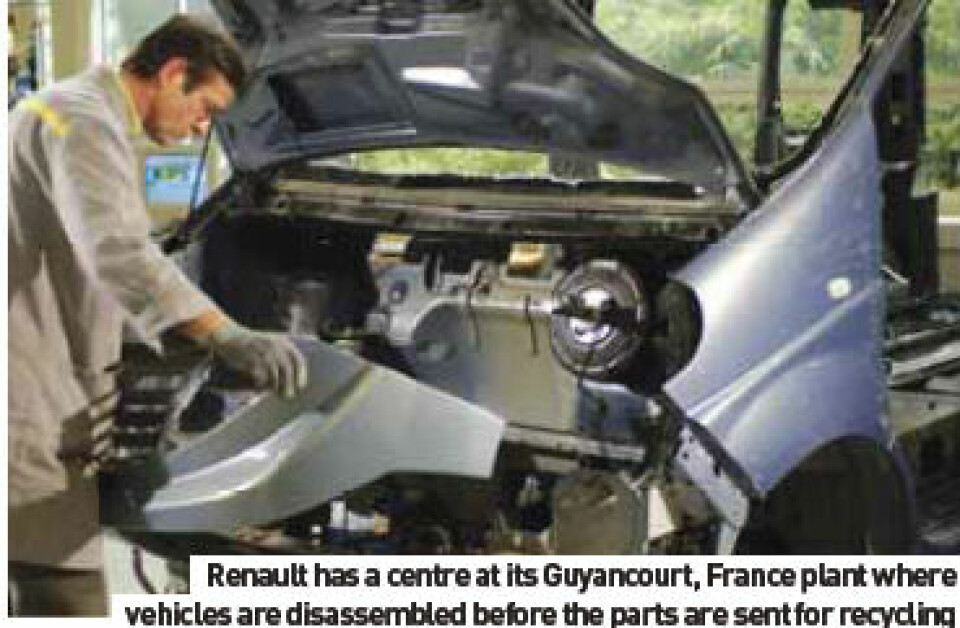
Scrap metal is classified as waste within the EU, but is generally considered as a secondary raw material or even as a separate product outside the boundaries of its operations. A spokesperson for Volkswagen explains: “Although our plants in Emden and Zwickau have largely identical processes and mostly similar levels of vertical integration, the share of hazardous waste recycled in Emden is approximately 60 per cent while it is almost 100 per cent in Zwickau. This is because the local authorities there classify some disposal processes as recycling, while in other German states they are classed as disposal processes.”
Balancing the conflict
The level of vertical integration at a plant is another important factor. It is much easier for a vehicle assembly plant to meet zero waste targets than a full production facility that incorporates a stamping shop, body shop, paint shop and possibly the manufacture of components, as these activities still generate significant quantities of scrap metal, filings, used oil and paint waste.
It can be easier to design waste management processes into a new plant than to add them into an existing facility. Kia has set up its plant in Zilina, Slovakia, to be as environmentally friendly as possible. The Korean carmaker wants this site to be ‘a leading example of how to balance the sometimes conflicting demands of manufacturing and environmental responsibility’. As proof of its success, the plant was recently awarded an ISO 14001 International Certificate of Environmental Management.
Waste not, want not
There are three main categories of waste generated by car plants: general waste such as packaging, metals from stamping and machining processes, and fluids. Packaging waste is best dealt with by simply reducing the quantity that ends up as waste. Almost all carmakers are now using reusable containers for component supply.
At Volkswagen’s main plant in Wolfsburg, Germany, packaging materials that used to be sent to landfill are now routinely recovered and reused or recycled. To assist with this, the carmaker developed an automated sorting station in partnership with Braunschweig/Wolfenbüttel University of Applied Sciences that can identify 120 separate types of packaging components. Introduced to the plant a decade ago, the process has also been installed at the carmaker’s Emden and Hannover facilities. Packaging, plastic and Nopa foam are classified and sorted for later resale to internal and external suppliers. Its Braunschweig plant has now completely done away with disposable packaging and uses standardised pallets and containers that can be returned to suppliers.
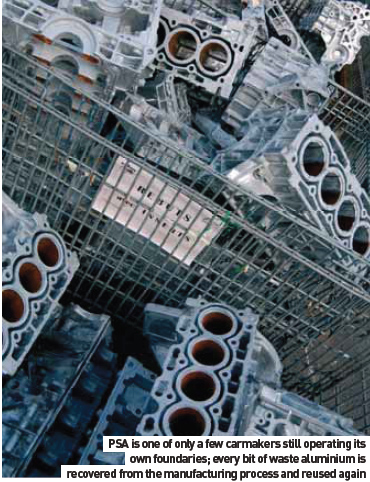
Composting solid, biodegradeable waste is another option. Since late 2006 – in a joint project with the University of São Paulo, Brazil – Volkswagen’s plant in that city has been developing an innovative composting process, with the aim of reducing total annual waste volumes by 70 metric tons, thereby helping to conserve local landfill space. Honda also reuses packaging materials to reduce waste. Its policies are quite aggressive and it is increasingly using returnable packaging for both local and international shipments. At present, the carmaker is exporting KD parts in returnable cases to 10 countries around the world, including the US and Canada, while almost half of all shipments to external companies now use returnable containers. Also, Honda has been looking at solutions to recycling plastic film materials, which accounts for a major part of the packaging materials used in transportation. A quick fix has been to stop using adhesive labels on the plastic film, which prevented recycling, with information now printed directly onto the film. At the Montesa Honda Factory in Spain, a system has been introduced to transport motorcycles imported from Italy without using any packaging materials. Known as the Non-Packing Import (NPI) system, the company plans to introduce this concept at its sites in other countries too.
In Lafayette, Indiana (USA) Subaru also has a zero landfill target. Wooden pallets are reused extensively, with those past repair made into new pallets or ground into mulch. Other initiatives include asking a supplier to use a type of shrinkwrap that could be more easily recycled and reducing the excessive use of protective plastic. Also, polystyrene inserts used to protect engine parts are reused five times before being recycled, saving US$1.3 million a year. A major area of activity at PSA is to reduce the quantity of non-reusable packaging. “It is much easier to reduce packaging at the time a new model is launched, but we have not yet found ways for all packaging on an assembly line to be reused,” says Francois Desmonts. Reducing cardboard and plastic film packaging is an on-going challenge, but old plastic and cardboard are extensively recycled via waste management contractors.
Metal and plastic
When it comes to raw materials, wasted material equates to wasted money. Volkswagen keeps metal waste to a minimum through a new optimisation programme designed to reduce waste during manufacturing. Designed to ascertain the minimum required surface area before stamping panels, the system reduces overall wastage. An optimised tooling programme has been introduced at the company’s commercial vehicles plant in Hannover, helping to save up to 840 tonnes of steel a year. BMW uses a similar system – all waste material from the stamping shop is collected and returned to the steel or aluminium supplier’s production cycle.
PSA is one of only a few that still operates its own foundries. “We have always worked hard to recover waste metal as we can use it in our foundries,” says Desmonts. Waste metal is recovered from a variety of sources in the manufacturing processes, including lubricants and fluids, in addition to the metalworking processes. Major waste reductions at PSA have come from adopting ‘lost’ foam technology to produce cylinder heads for the company’s new gasoline engines. “The lost foam process is inherently low-waste,” says Desmonts. Importantly for this particular process, PSA has developed a way of cleaning the sand used in the lost foam process to make it suitable for reuse, a great savings in cost and materials.
As with the treatment of plastics, Volkswagen worked with two partners, Care and Ticona to develop a process to reuse production waste from the manufacture of instrument panels for the Golf and Golf Plus. Waste material from the production of the panels is chopped and refined for conversion into pellets. Added back into the manufacturing process, the ‘waste’ is then incorporated in later panels made for the same cars, a programme that won an award from the German Federation of Reinforced Plastics in 2006.
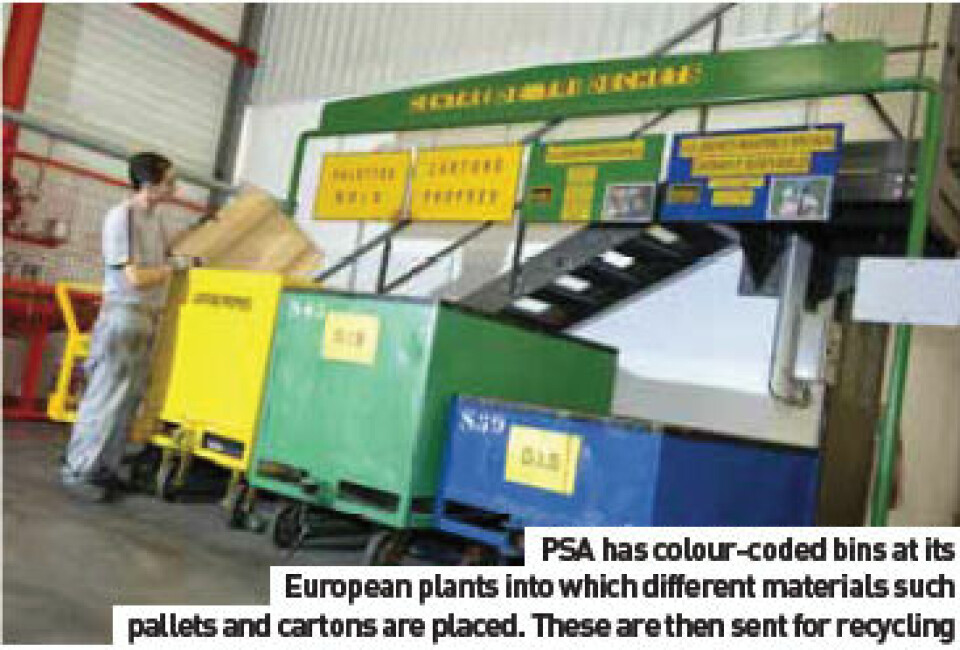
Fluids – the environment’s worst enemy
According to Ford, metal-working fluids and associated waste are potentially the most damaging environmental factors associated with engine production at its Dagenham, UK site. Of the two million litres of metal-working fluid used on site, 400,000 is now pure vegetable oil. Because vegetable oil-based lubricants are used at reduced concentrations compared with conventional fluids, coolant consumption is down from 350,000 litres in 2003 to 204,000 litres last year. Combined oil conservation at Ford Dagenham exceeds 500,000 litres per year. To further reduce waste, the carmaker diverted all nonoil wastes from the plant (plastics, wood, and paper, for example) away from landfill sites. For oily ferrous sludges, Ford has implemented a briquetting process, changing the sludge into pucks, which are then used as feedstock in the cement industry.
Metal briquettes, worth over £700 (about US$1,400) per tonne, are created from swarf left over from machining billet blocks. Recovered from metal working fluid and dried, these can then be fed back into the industry and used for, among other things, brake castings. “Briquetting on this scale was unique to Ford when we started more than three years ago, with production machinery to process and compact waste metal built especially for Dagenham’s application,” commented a Ford spokesperson.
Like Ford, Toyota also supplies the cement industry, though by a different route. A large contributor to its landfill waste was sludge from the paint shop. Running the waste through a centrifuge removed water from the sludge that could be pumped back into the paint ponds for re-use, with the added benefit that the remaining dry residue could be used in cement production.
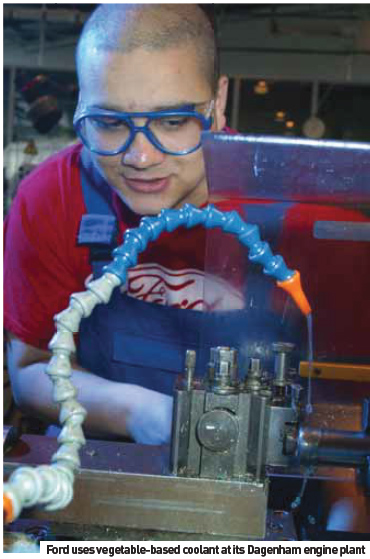
Using recycled materials
One of the first rules of recycled materials is to maintain a demand for them. To this end, Daimler maintains that approximately ten per cent of the plastics used in its C-Class are made from recycled materials. Some 32 components (with a combined weight of 40kg) can be manufactured using a high proportion of recycled plastic.
BMW shares the idea of reusing recycled materials, with the company aiming to increase the proportion of recycled plastics up to 20 per cent. The rear shelf on the BMW 1 Series consists of approximately 85 per cent recycled materials, while various components on the model are continuously being updated to incorporate recycled material. When a new use for a recycled material is identified, where possible, it is quickly passed between the model ranges for incorporation. At Toyota’s Burnaston plant, the Facilities and Environment team realised that much of the water used to wash and rinse assembled car bodies before painting could be reused in boilers to generate steam. The water required treating and cleaning, so a reverse osmosis unit was installed, comprising a series of filters and membranes to remove particulates. In the first year of operation, the company estimated that more than 100,000 tonnes of water was saved.
Reducing the water used in manufacturing also helps to reduce carbon emissions produced during water treatment and delivery. According to Kia, the company’s most recently completed plant has this goal in mind. “Reducing the overall quantity of materials used in the manufacturing process helps to minimise emissions. Kia Motor Slovakia is aiming to reduce water consumption by cutting the water used in vehicle production and minimising the generation of waste water in all processes.”

Informed workforce
Another strategy to reducing waste is to engage plant workers in the process. “We will only be able to reach our goal of zero landfill with the support of our workforce,” says PSA’s Desmonts. Volkswagen’s plant in Martin, Slovakia, increased the proportion of reused or recycled waste to 84 per cent in 2006, largely because of staff training and what the company terms ‘systematic ideas management programmes’.
Said a company spokesperson, “We also do a comprehensive exchange of experience among the waste disposal specialists at our plants, who meet at least twice a year to discuss optimised disposal, and legislative developments, among others.” At its Wolfsburg plant, an ‘environment team’, consisting of staff no longer able to carry out heavy lifting duties, for whatever reason, sorts waste such as plastic film and metal foil, cardboard, foam packaging and other protective covers from engines, gearboxes and other components. The sorted material is then classified and reprocessed using state-of-theart technology.
“The team not only performs a waste management function, but also fulfils an important social function by giving team members a job in keeping with their abilities, which is acknowledged and recognised within the company and brings economic benefit. This is an example of sustainability at its best,” the spokesperson said. Vehicle makers are by nature innovators and each company they do business with has the chance to learn from their applied solutions. In fact, many carmakers now require their suppliers to have environmental management systems in place. All members of the Toyota supply chain recognise the significance of environmental issues and should comply with the company’s goals in terms of waste management. To achieve this, Toyota carries out ‘Duty of Care’ audits to ensure that once waste has left the plant, it is dealt with in the correct way. Reducing waste also offers financial rewards. At its Dagenham plant, Ford says that it has saved over £3m (about US$6 million) by cutting waste and reducing energy use. Of this, almost £1.6m has come from avoiding landfill, £1.2m from processing sludge waste, with the remainder coming from energy savings.
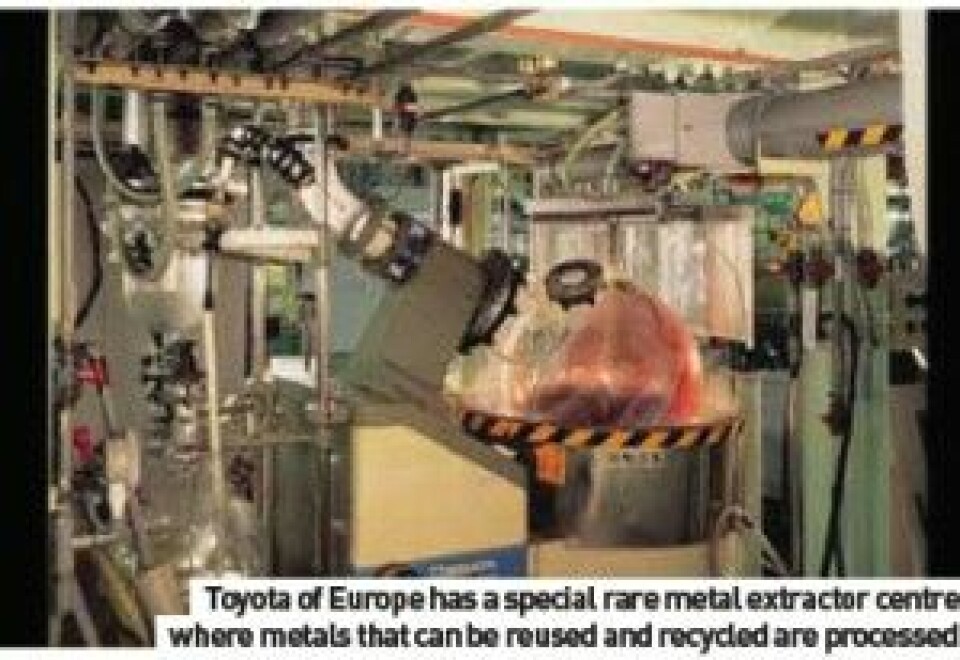
Outsourcing waste management
Another option is to outsource waste management. Vauxhall, for example, outsources waste management at its Ellesmere Port, UK plant to Centrol Recycling Group. This involves supplying recycling equipment on site, including baling and sorting machinery. As part of the total waste management contract, Centrol provides staff, management and environmental data, in line with GM’s worldwide policy. Many other companies send waste to outside contractors. Ford Dagenham’s waste is sorted and recycled at a facility operated by Shanks Group, located near to the plant. Kia’s Zilina plant contracts waste management to a company called TSR Czech Republic for metal recycling, while all other waste, paper, plastic, wooden pallet, glass, cardboard, copper and oil is processed by ASA Slovakia.
With this in mind, it is interesting to note that according Honda, if the company relied on outside contractors, it would not be able to achieve the zero landfill goal. Where there is a technological problem, Honda prefers to develop its own solution.
One example of this is the development of a device to remove foreign matter from incineration ash, making it possible to recycle 2,100 tons of incineration ash as cement or paving that would otherwise have been sent to landfills.
The BMW Group has a long tradition of environmental protection: in 1973, the company was the first vehicle maker in the world to create the Group ‘Environmental Protection’ function, with farreaching overall responsibilities. In signing the United Nations ‘Cleaner Production’ declaration in 2001, the company again confirmed its commitment to implementing environmental protection in its production facilities. Today, about 70 staff across the globe work in the BMW Group’s environmental protection organisation.
Cleaning up production The BMW Group is working on continually improving its protection of the environment in its worldwide production network, with the motto ‘Clean Production.’ One of the most important milestones in this respect has been achieved in the BMW engine plant in Steyr through the application of a completely new process and waste water concept. Using a new combination of various membrane technologies, all manufacturing waste water in the plant is treated and fed back into the production system. The result: the mains drainage connection for operating waste water from the production area was closed at the end of 2006, which means that around 30 million litres of water will be saved each year. Water is used to create an emulsion with coolants for milling and turning, and for washing or rinsing during the fi nishing of cylinder heads, crank cases, crankshafts and connecting rods. Even in the BMW engine plant in Steyr, which produces around 60 per cent of all BMW engines, water is an element that cannot be replaced. However, using considerable technical skill, it can be treated. A waste-water treatment system using nanofi ltration technology was introduced in 2003. To put this into perspective, the 30 million litres of water that BMW will save annually is the same amount of water used by 750 people in a year. Worldwide environmental policy The BMW plant in Steyr is thus not only easing the burden on the environment, but is also saving a considerable amount on sewage charges.
At all its locations, environmental management systems – which go far beyond what is required by law – guarantee environmental protection within the company’s operations. In 1999, the BMW Group was the fi rst vehicle maker worldwide to certify all its production locations uniformly in accordance with international environmental management standards.


